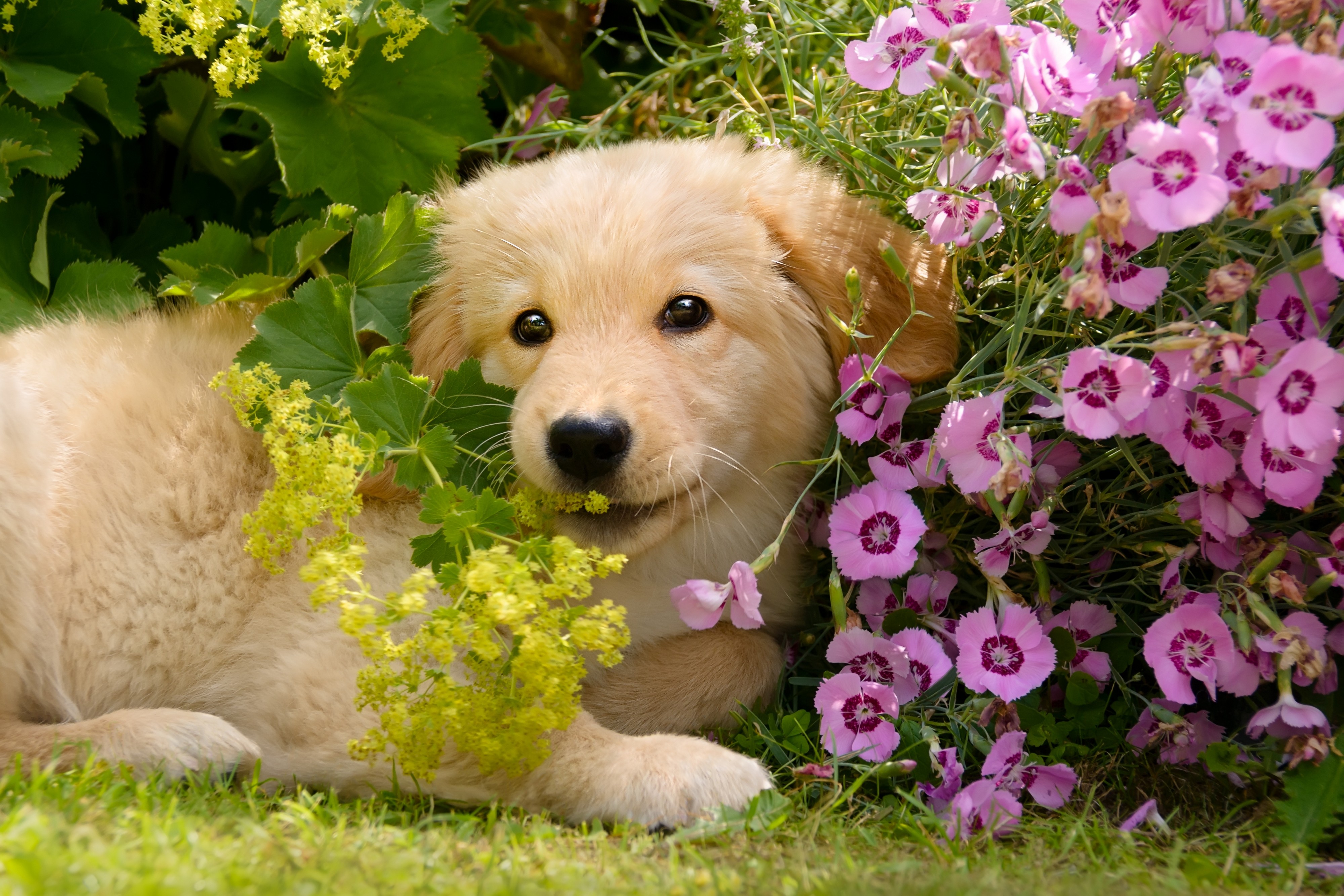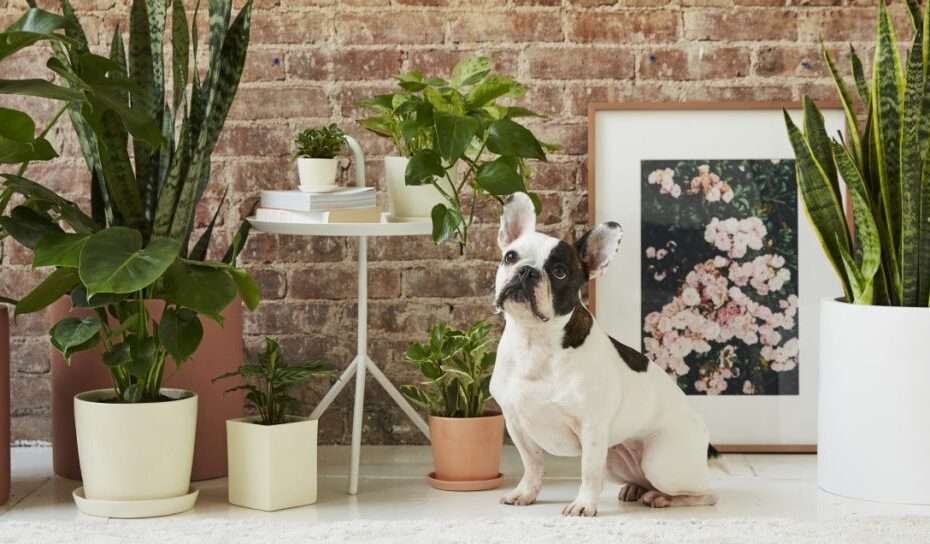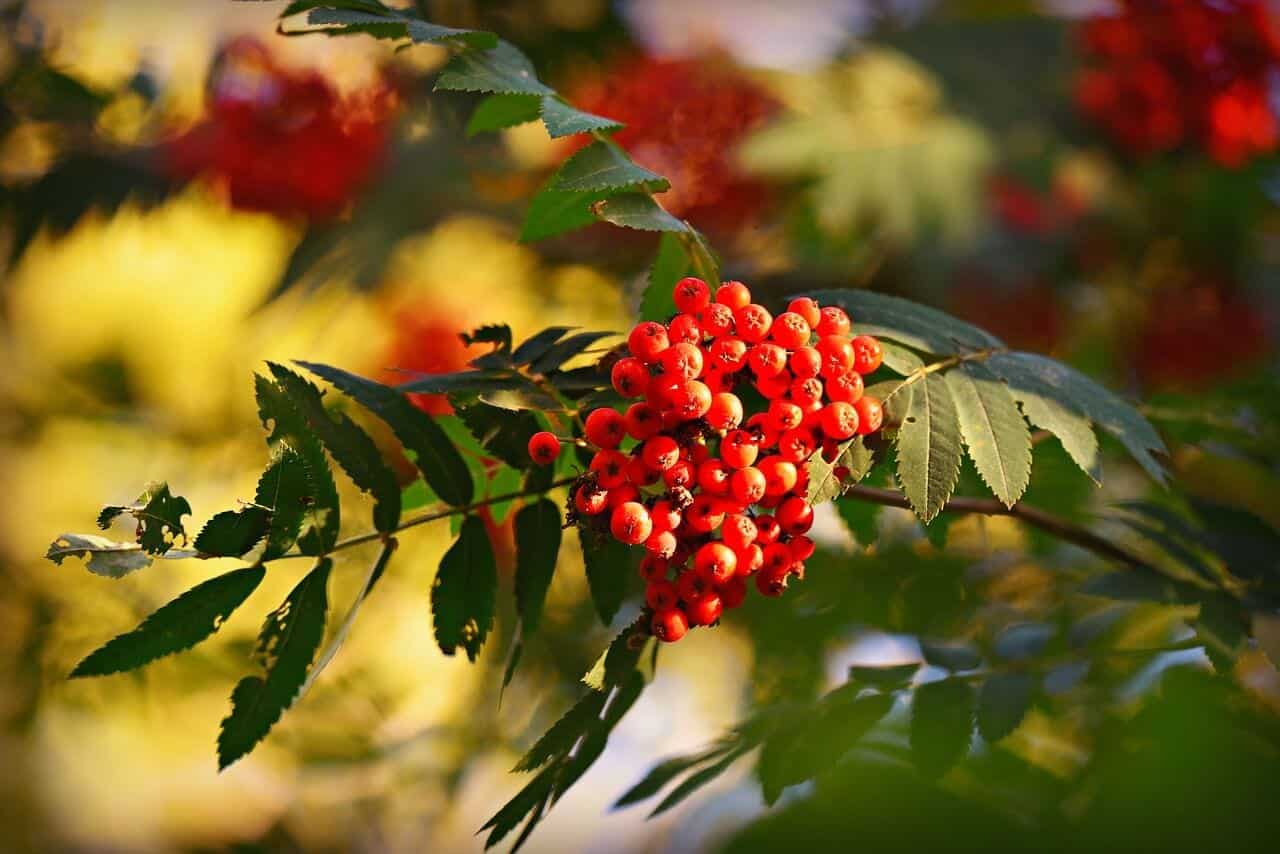Toxic plants for dogs
Some dangers for our dog friends are closer than you think: house plants, flowers from the garden or found in the forest... Plants are the cause of many poisonings every year.
The wisest dogs are generally out of danger, but the most gluttonous animals and puppies up to the age of eight months, tend to swallow anything!
To avoid the risk of poisoning, we propose today a list of common plants that are toxic to the health of our four-legged friends, in the wild as well as at home.
What is a toxic plant for dogs?
Poisonous plants must be distinguished from edible plants, which are not intended to be eaten for taste reasons, but which do not cause any discomfort if ingested. Conversely, plants treated with pesticides, even if edible, are not toxic in themselves, but can still poison your pet.
Thorny plants, such as cacti, can also be a danger to your dog because of their spines, but they are not necessarily toxic. Poisonous plants contain substances that can damage your dog's body.
The toxicity of each plant varies depending on the nature of the plant and the health of the dog, and not all plants cause the same symptoms or contaminate in the same way. For example, some plants may have edible fruits but toxic leaves, or may only be toxic at a certain time of maturity.
Moreover, the mode of intoxication may vary (inhalation, ingestion, skin contact, etc.) depending on the different species of plants. Poisonous plants are likely to cause digestive disorders, nerve damage, or even death of the animal.
Poisonous plants for dogs in your garden
Rhododendron, Azaleas: under these two names are hidden similar shrubs belonging to the Ericaceae family and very popular for their pretty trumpet-shaped flowers. These plants contain andromedotoxin, arbutin, aricoline and rhodoxanthin, moderately toxic substances that can cause digestive, nervous, respiratory and cardiovascular disorders. The intoxication takes place by the ingestion of leaves, flowers or fruits, and even the honey resulting from Rhododendron would have hallucinogenic and laxative effects.
Brunfelsia: native to Brazil, Brunfelsia is a plant found in gardens. It is the roots and bark of this plant that are toxic, causing diuresis (production of urine), heart problems, tremors and, in severe cases, death.
Gloriosa: this beautiful South African plant can be grown in pots in France, indoors or outdoors. Extremely rich in colchicine, all its parts are very toxic for mammals, blocking cell division and causing important digestive, blood and neurological disorders that can cause death.
Ricin: this tree-like plant originating from tropical Africa is now found in temperate zones where it is appreciated for its beautiful purple leaves and rapid growth. The entire plant is highly toxic in small doses, as it contains ricin, a poison that causes digestive (vomiting, diarrhea), hemorrhagic and sometimes urinary disorders. A fever and a general depression can also be observed, as well as liver and kidney damage leading - in the absence of treatment - to a coma and then death.
Oleander: As well known for its beautiful flowers as for its toxicity to humans, oleander does not spare dogs either. The entire plant is toxic, as well as any water in which leaves may have fallen or its roots soak. Oleander contains oleandrin, a substance that causes cardiovascular problems in mammals.
Arum: these beautiful white flowers from Ethiopia are now widespread in European gardens. There are different types of arum, and all are poisonous in their entirety due to the presence of insoluble calcium oxalate crystals whose caustic effect causes burns, edema, and even hemorrhagic pitting. Because of the discomfort of chewing arum, dogs rarely swallow it, but when they do, they may experience digestive problems and, in extreme cases, hemorrhage, systemic problems, coma and death.
Boxwood: A small shrub often found in hedges, boxwood contains alkaloids, toxic substances with paralytic action. All parts of the plant are toxic in small quantities to all mammals, but the bitter taste of boxwood fortunately discourages animals from ingesting enough to be seriously poisoned. In case of ingestion, the dog quickly presents digestive disorders (vomiting and diarrhea, sometimes hemorrhagic), then nervous disorders (convulsion, paralysis, abatement).
Cyclamen: often grown in the shade of large trees in gardens, cyclamen contain cyclamine, a toxic substance causing irritation of the mucous membranes. In case of ingestion, the dog can present intense digestive disorders (vomiting, diarrhea) and possibly nervous.
Hydrangea: Very common in gardens, Hydrangea contains a toxic substance similar to cyanide. All parts of the plant are toxic, and their ingestion causes nervous, muscular, cardiac and hepatic disorders, resulting in asphyxiation.
Dahlia: These pretty, colorful flowers can cause skin inflammation, irritation and itching in your dog, as well as minor digestive problems. The toxin involved is not yet known, and dahlia poisoning is generally not serious for the animal.
Buttercup, Buttercup: this small yellow flower found in gardens and meadows can cause digestive problems in dogs.
Clematis: Toxic to dogs and cats, this beautiful flower fortunately has a very bitter taste that discourages animals from eating enough to be severely intoxicated. If ingested, the dog may experience digestive upset and hyper salivation.
Begonia: there are thousands of different species of begonias, and all of them are toxic for our friends the dogs. Their ingestion, especially the roots, causes intense burns in the mouth and digestive system that can lead to vomiting.
Acacia: a tree found in forests and gardens, acacia contains a substance that is highly toxic to dogs. All parts of the plant contain aconitine, aconine and benzylaconine, neurotoxic poisons that can cause digestive disorders and nerve damage.
Jasmine: well known for its sweet scent, much appreciated by humans, jasmine is toxic for dogs. Its sap, in particular, causes digestive disorders (vomiting, diarrhea) and, in the case of the most serious intoxications, neuromuscular disorders.

Poisonous plants for dogs in the wild
Aconite : the most toxic plant of Europe, Aconite contains alkaloids (napelonine and aconitine) which cause a respiratory paralysis. The ingestion of all the parts of the plant, but especially of its roots, involves initially digestive disorders, then respiratory and cardiovascular.
Foxglove : well known to hikers and walkers, the foxglove is a beautiful flower that we regularly come across All parts of the plant contain a violent toxin, digitalis, which causes serious heart problems.
Spiny tarragon: this shrub often found in the forest contains toxic saponosides. All parts of the tree are toxic and cause digestive disorders and destruction of the animal's red blood cells (hemolysis).
Rosehip, dog rose, hedge rose: this bush, which is often found in wasteland or along the roadside, contains cyanogenetic heterosides. Ingestion of leaves or flowers in large quantities can cause respiratory and nervous disorders.
Glycine: widespread in gardens as well as in the wild, Glycine Wisteria is a tree whose seeds contain lectin, a toxic glycoprotein. All parts of the plant are toxic and cause hemorrhagic gastric disorders, neural disorders and, in the most serious cases, death.
Autumn Colchicum, Autumn Crocus: these pretty saffron-like flowers, commonly found in European meadows, contain colchicine, a substance toxic to all mammals. Their ingestion, even in small doses, blocks cell division and causes violent digestive disorders, as well as blood and neurological disorders that can cause death.
Yew : as present in gardens as in nature, yews are non-coniferous conifers, often used to make hedges, because they are easy to prune. The whole plant is toxic, except the fleshy part of the fruit, but poisoning occurs more often in herbivores that chew the leaves of the shrub. Symptoms occur rapidly, but are often mild in dogs: vomiting, diarrhea, dry mouth or hyper salivation, followed by neurological disorders if the animal has ingested leaves or chewed seeds. At this stage, the prognosis is unfortunately poor and death usually occurs quickly.
May Lily of the Valley, Common Lily of the Valley: these small white bell-shaped flowers are widespread in the wild in temperate zones, especially in forests. All parts of the plant are highly toxic and can be fatal to a dog in just a few minutes. Lily of the valley contains saponosides and cardiotoxic heterosides that cause serious heart problems.
Amarillys, Daffodils, Iris, Narcissus, Snowdrops: these pretty flowers found both in nature and in gardens contain toxic substances, especially in the bulb, although the whole plant is dangerous. They contain alkaloids that can cause moderate to serious digestive disorders, fortunately rarely fatal.
Ivy: this climbing plant that we find in the forest as well as on the walls of our homes is toxic to mammals, especially the berries it produces. The ingestion of all parts of the plant, but especially its berries, causes burns and irritation of the mucous membranes and digestive system. Ivy contains saponosides, an irritating substance that causes digestive disorders and, in the most serious cases, hallucinations, convulsions, coma and death.
Oxalis, Cuckoo's bread, False four-leaf clover: these small wild flowers that are sometimes found cultivated in gardens are edible in small doses, but toxic in larger quantities because of the oxalic acid they contain. Ingestion of large quantities of oxalic acid causes irritation of the mucous membranes and digestive system and, in very large doses, blood and kidney disorders.
Mistletoe: this plant which forms large leafy balls that can be seen on the high branches of trees in the forest is a hemiparasite absorbing the sap of its host. All parts of the plant contain many toxic substances, including polypeptide alkaloids, saponosides and resin alcohols, which can cause digestive disorders, then - in large doses - cardiovascular disorders, pharyngeal edema, respiratory disorders and a drop in blood pressure.
Holly: this plant which often decorates interiors at Christmas contains alkaloids in its leaves and fruits, and their very large consumption can lead to digestive and neurological disorders, and even death. Fortunately, the fruits are emetic (causing vomiting), which prevents them from being consumed in large quantities, and serious poisoning is extremely rare.
Oak: Some species of oak trees yield poisonous acorns that even the most gluttonous dogs will swallow. Acorns, especially when they are still green, contain a tannin that releases pyrogallol, a substance that is harmful to the kidneys. Poisoned dogs show signs of depression, digestive problems and damage to the liver and kidneys.
Saponaria officinalis: widespread in wetlands, it is an enterotoxic plant that can cause severe digestive disorders, urinary disorders (anuria), paralysis and liver damage.
Privet, Trouille, Blackwood: often used to create hedges, privet contains ligustrine, a toxin responsible for digestive, cardiac and respiratory disorders. If ingested in large quantities, privet can cause neurological disorders (lameness, paralysis) and lead to the death of the animal.

Plants that are toxic to dogs in your garden
Rhubarb: The leaf blades and leaves of this bitter plant contain oxalic acid and anthraquinone glycosides. These toxic substances can cause vomiting, abdominal pain, diarrhea and kidney damage in humans and dogs.
Avocado: this delicious fruit contains persin, a fatty acid that dogs are unable to metabolize. In fact, all parts of the plant are toxic for our four-legged friends, causing digestive problems at first, then respiratory and cardiovascular problems.
Tomato: while the ripe fruit is not toxic to dogs in small quantities, the leaves and stems of tomatoes contain large quantities of solanine, glycoprotein and glycoalkaloids. These substances can cause more or less severe poisoning, which can result in digestive problems, muscle weakness, increased heart rate and hyper salivation.
Potatoes: like tomatoes, potatoes contain solanine and ingestion of peels, leaves, unripe fruit and, especially, sprouted or wormed tubers can be problematic. This substance has an irritant action that leads to digestive disorders, and a nervous toxicity causing tremors, lameness, dizziness and hypothermia.

Houseplants that are toxic to your dog
Cannabis: some species of cannabis can be grown for decorative purposes, but they are all highly toxic to dogs and cats. The substances contained in all parts of the plant can cause a nervous breakdown leading to the death of the animal.
Chrysanthemum: These beautiful flowers, which often adorn tombstones and are honored during All Saints' Day, contain pyrethrins. This toxic substance affects the dog's digestive system and can cause nervous disorders when ingested in large quantities.
Yucca: All parts of the Yucca plant, with the exception of its flowers and seeds, are highly toxic and cause digestive problems accompanied by hypothermia. In cases of acute intoxication, Yucca can cause paralysis, coma and death.
Croton: this plant contains diterpene and croton oil, substances that are particularly toxic to dogs. All parts of the plant are toxic and can cause burns, digestive disorders and nerve and cardiovascular damage.
Sanseviéra, Mother-in-law's tongue: this indoor plant native to Africa is moderately toxic for dogs. Ingested or chewed in small doses, it mainly causes local irritations and digestive disorders, but in larger quantities it can cause nervous disorders.
Aloe Vera: despite its cosmetic virtues appreciated by humans, Aloe Vera is highly toxic for animals. The plant contains saponins, an active ingredient that causes digestive problems, local irritation and neurological disorders.
Aglaonema: the leaves of this beautiful houseplant are highly toxic to dogs due to the presence of calcium oxalate in its sap. Its ingestion leads to digestive disorders, severe respiratory disorders capable of causing asphyxiation and cardiac disorders.
Ficus: this plant gets its toxicity from the latex it contains, a highly irritating substance that causes digestive disorders, local burns and hyper salivation.
Citrus: the whole family of citrus trees is highly toxic to dogs by ingestion, as well as by simple contact. Citrus trees have an irritating and photosensitizing action, they can cause digestive disorders and important burns.
Cycas: very similar to small palms, Cycas are native to tropical areas and usually live indoors or, eventually, in gardens. The seeds and leaves of this plant contain cycasin and 2-amino-3-(methylamino-)-propanoic acid, substances that are highly toxic to the liver. The first symptoms appear between 1 hour and 3 days after ingestion and consist of digestive disorders (vomiting, diarrhea), then nervous disorders (tremors, lameness). Jaundice (yellowing of the skin and mucous membranes) and coagulation disorders (bleeding) can then be observed when the liver is affected, leading to the death of the animal.
Schefflera: like many tropical plants, Schefflera contains latex which makes its sap irritating to the skin. The ingestion of leaves can also cause digestive and nervous disorders in dogs, but cases of serious poisoning are fortunately rare.
Poinsettia, Christmas Star: very irritating, this plant is often used to create floral arrangements because of its beautiful bright red flowers. The intoxication is often benign, and manifests itself by digestive disorders (vomiting, diarrhea and salivation) due to an irritation of the mucous membranes of the digestive system.
Liliaceae, Lilies, Hemerocallis: these pretty flowering plants are moderately toxic to dogs, and much more severely so to cats. The ingestion of any part of the plant or its pollen causes, in the dog, digestive disorders generally moderate.
Arbus Precatorius, Rosary Tree, Jéquirity Seeds, Red Peas, Paternoster Bean: all these names refer to a climbing shrub, whose fruits are pods containing very hard red seeds. Its beautiful seeds, which are among the most poisonous in the world, are used to create rosaries, jewelry, musical instruments and ornamental objects. Containing arbrine, the seeds of Arbus Precatorius can be deadly and, if they do not represent any danger in case of contact with the skin, should not be crunched!
Dracaena, Dagonier, Lucky Bamboo: this decorative plant, very similar to the common bamboo, but which does not belong to the same species of plant, is as pretty as it is toxic for dogs. The different species of Dracaenas cause vomiting, sometimes hemorrhagic, general apathy, loss of appetite and hyper salivation.
Dieffenbachia: a plant with large leaves often found indoors, Diffenbachia contains calcium oxalate crystals with a caustic effect. If your dog rubs it too closely or chews its leaves, he or she may suffer burns, mouth ulcers or skin irritations and even edema, which fortunately are not serious in most cases.
Elephant ear, Alocasia macrorrhiza: this plant contains a substance similar to that of Dieffenbachia and presents, in fact, the same toxicity for dogs.
Philodendron: Philodendrons are moderately toxic due to the presence of oxalic acid in all parts of the plant. Their ingestion may cause irritation in the animal's mouth and possibly digestive disorders and hyper salivation.
Love tree: this ornamental plant, which is found indoors in temperate zones, produces fruits containing steroidal alkaloids. These toxic substances have an irritant action and can lead to the destruction of the cell membrane (lysis). The intoxicated dog may show vomiting, colic and diarrhea, as well as dilated pupils (mydriasis) and a slowed heart rate (bradycardia).

FAQ
What should I do if my dog has eaten a poisonous plant?
If your dog has ingested a poisonous plant, the best thing to do is to contact a poison control center or veterinarian before symptoms appear. If you don't know the name of the plant, go directly to your veterinarian and bring the plant with you if possible. Care is always more effective when the veterinarian knows which poison is involved.
What is the difference between a toxic plant and a harmful plant for the dog?
The difference between a noxious or toxic compound is primarily a matter of severity: a toxic plant causes significant and immediate - or rapid - damage to the dog's body, while a noxious plant is bad for the dog's health in the long term or in large quantities. Also, the plants listed in this article are toxic to dogs, not just harmful.
What are the symptoms of poisoning in dogs?
Symptoms vary depending on the plants involved, but digestive problems are almost always present when poison is ingested. The health of your pet also has a considerable impact on the symptoms caused by a poisoning: a healthy dog may not show any damage after ingesting a moderately toxic plant, while a weakened animal will be quickly down, feverish or trembling.
Are plants that are toxic to dogs toxic to humans?
It all depends on the plant in question: some are toxic to all mammals, even birds and reptiles, and others poison only certain living creatures. Humans, unlike dogs, are omnivores and have therefore developed the ability to digest compounds that are poorly tolerated by carnivores, such as alkaloids.
Moreover, poisoning of a human by a plant is rarely fatal, while it is often tragic for a dog. To avoid the risk of poisoning, it is ideal to always watch your dog in the wild, especially if it is a young animal or a glutton.
Knowing the plants around you and their toxicity is also essential to avoid putting them within reach of your companion and to detect a potential danger while walking. The above list of plants should help you recognize most of the potential killers lurking in your garden, home or nearby woods.

